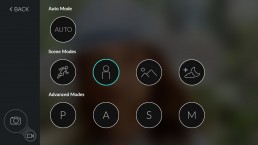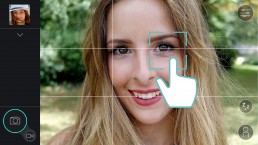Portraits Depth of field
To take a beautiful portrait, it’s important to light the subject well, help the person feel comfortable, and capture a natural expression.
You can take a portrait anywhere — in your house, on a trip, or with friends or family — the possibilities are endless. Look for a place with a neutral background, such as the horizon line, a curtain, a building, or a faraway landscape, where the light is soft and even.
With its 32 mm focal length, ƒ/1.8 aperture, and beautiful bokeh effect (artistic background blur), your DxO ONE is great for taking portraits.
If you want to work in a more spontaneous manner without having to make complex adjustments to your settings, use the DxO ONE’s Portrait scene mode. This mode prioritizes the aperture to create beautifully blurred backgrounds and the soft colors that are best suited for portraits.
It’s best to focus the camera on the subject’s eyes. To do that, select the focus area by pressing the shutter button halfway down or by tapping on your smartphone’s screen.
(Photographer Florence AT)
To ensure that the entire face is in focus, close down the diaphragm slightly (between ƒ/2.9 and ƒ/4) in mode A (aperture priority) to increase the depth of field and expand the focus area. Check the shutter speed display. This value should not go below 1/60 s when shooting a stationary subject to avoid any motion blur. If the shutter speed is below this value, increase the sensitivity until the shutter speed is fast enough.
As for your staging, stick with the basics. Using your surroundings is easy — just remove any unnecessary objects around your subject from the frame.
In terms of lighting, natural light produces excellent results. When shooting in front of a window, get rid of shadows by creating an improvised reflector. A white surface like a white wall or a white sheet of paper should be enough. When photographing children, make harsh light softer by placing a veil or a piece of tracing paper between the source of light and your subject. The light will be more diffuse and any shadows will be reduced. Take advantage of a cloudy day to take portraits outside, since clouds can also reduce shadows.
Before a formal portrait session, take time to talk with your subject to put him or her at ease. Explain what you’ll be doing as you help the person check that their collar is even and/or their hair looks good. It’s useful to know how to apply makeup to bring out the person’s features and to cover up blemishes, which also helps you avoid having to do a lot of editing later on and shows your subject that you want to take a good photo of him or her.
Portraits are best taken as vertically-oriented images. Observe your subject and walk in a circle around him or her to find their best side. Lead the person away from the background and ask him or her to move to a three-quarters position to give the image added depth. Don’t cut off the person’s head, hands, or feet, and position his or her eyes on the upper line created by the rule of thirds.
Ask your subject to remain silent while you’re taking photos to avoid capturing the person mid-word. Each face is different and every expression is unique. Concentrate on the person’s face and press the shutter button frequently. A good portrait should show the subject’s personality above all else. To understand the process from the subject’s point of view, sit for a self-portrait by setting your camera on a tripod and use the DxO ONE’s 10 second timer option to trigger the shot.






 Download page
Download page